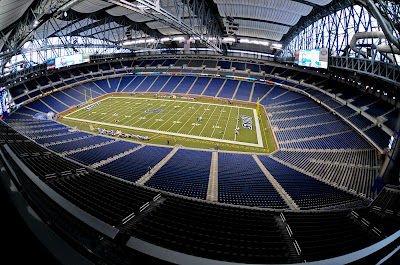Ford Field - Home of the Detroit Lions NFL Football Team
Monday
About Ford Field - Home of the Detroit Lions
Welcome to a new blog entirely about Ford Field, home of the NFL's Detroit Lions franchise!
Ford Field is an indoor American football stadium located in Downtown Detroit. It is the home field of the National Football League's Detroit Lions. It is owned by the Detroit/Wayne County Stadium Authority. It regularly seats 65,000, though it is expandable up to 70,000 for football and 80,000 for basketball. The naming rights were purchased by the Ford Motor Company at $40 million over 20 years; the Ford family (including Lions owner William Clay Ford, Sr.) holds a controlling interest in the company.
Ford Field was originally planned to be an outdoor stadium, simultaneously with Comerica Park, which opened in April 2000, as part of a public project to replace Tiger Stadium and thePontiac Silverdome. Ford Field was constructed after Comerica Park, opening in 2002. It cost an estimated $430 million to build, financed largely through private money, public money, and the sale of the naming rights.
The stadium's design incorporates a six-story former Hudson's warehouse, which was constructed in the 1920s. Hammes Company, a real estate development company in Middleton, Wisconsin, developed the new stadium, as well as the warehouse.
The presence of the warehouse allows for a seating arrangement that was unique among professional American football stadiums at the time of Ford Field's opening. The majority of suites at Ford Field are located in the Hudson Warehouse along the stadium's southern sideline, as are the lounges that serve the premium club seats on that side of the field. The bulk of the grandstand seats are located along the northern sideline and both endlines, with gaps in the stadium's upper half at the southwest and southeast corners. The upper deck on the stadium's northern sideline also contains one level of suites and a smaller section of club seating. A similar design was implemented at the renovated Soldier Field, albeit with the use of a new structure (as opposed to an existing building) to house four levels of suites.
Unlike most indoor stadiums, Ford Field allows a large amount of natural light to reach the FieldTurf field, thanks to immense skylights and large glass windows at the open corners. The windows along the ceiling are frosted to mimic the automotive factories that are prevalent in Metro Detroit. The southwest corner provides the seating bowl and concourse with sunlight year-round and also offers fans a view of downtown Detroit. To prevent the stadium from becoming an overly imposing presence in the Detroit skyline, the playing field and lower bowl (100 level) were set below street level, similar to the design at adjacent Comerica Park.
Ford Field is one of the few venues in the NFL that has end zones in the east and the west (the others being Qualcomm Stadium, Arrowhead Stadium, Cowboys Stadium, Sun Life Stadium, the Georgia Dome and Cleveland Browns Stadium). The NFL has a rule against this type of construction, so that the sunlight can not be a major distraction to the players on the field. The NFL had to give permission for the east–west end-zone construction, because the Hudson's warehouse would have required alterations otherwise. The natural light is not a distraction to the players in a day game, because the light only reaches as far as the sidelines, leaving the field still properly lit with the combination of artificial stadium lighting and sunlight.
Subscribe to:
Posts (Atom)









